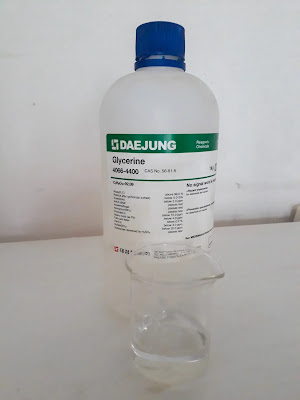- Product Namely: Glycerine.
- Signal Sign: Warning!
- Safety Insights – Glycerine SDS!
HAZARDS IDENTIFICATION
- Skin & significant eye injury, corrosion, or irritability are all hazards.
- It irritates the skin & the eyes.
- Given that it was stored with other chemicals that are not food-grade, the product should be handled as a chemical & should not be consumed.
COMPOSITION, INFORMATION ON INGREDIENTS
- Name of Component: Glycerine.
- CAS Number: 56-81-5.
- Formula: C3H5(OH)3.
- Weight of Formula: 92.094 g/mol.
- Synonyms: 1,2,3-Propanetriol, Glycerin, Glycerol.
FIRST-AID MEASURES
- If you feel unwell, contact a doctor.
- If inhaled: Remove the victim to fresh air & keep them at rest in a breathing-friendly position.
- If in the eyes: Carefully rinse for a few minutes with water. If contact lenses are present and simple to remove, do so. Rinsing continues.
- If on the skin: Thoroughly rinse with water.
- If Swallowed: Rinse mouth if swallowed. If you feel unwell, contact a doctor.
- If eye or skin irritability continues, seek medical assistance or care.
FIRE-FIGHTING MEASURES
- Combustible liquid class IIIB.
- 177 °C, the flash point (open cup) Autoignition Dimensions: 393 °C
- Toxic gases could be released during decomposition when heated.
- Use a tri-class dry chemical fire extinguisher in the event of a fire.
ACCIDENTAL RELEASE MEASURES
- Fill a sealed bag or container with sand or other absorbent material to contain the spill.
HANDLING & STORAGE
- Store alongside amides, amines, glycols, and alcohols.
- Store in a dry, cold environment(place).
EXPOSURE CONTROLS, PERSONAL PROTECTION
- Wear appropriate eye protection, gloves, & clothes.
- After handling, carefully wash your hands.
- Recommendations for exposure (As a complete mist) PEL 15 mg/m3 (OSHA).
PHYSICAL & CHEMICAL PROPERTIES
- Appearance: Clear.
- Color: colorless viscous liquid.
- Odor: Odorless.
- Soluble: Water and alcohol.
- Boiling point: 290°C
- Melting point: 18°C
- Refractive index: 1.4746.
- Specific gravity: 1.23 – 1.26.
STABILITY & REACTIVITY
- Avoid coming into contact with strong oxidizing substances like potassium chlorate, potassium permanganate, or chromium trioxide since they could explode.
- Shelf life: If properly preserved, indefinite.
TOXICOLOGICAL INFORMATION
- Acute Effects: May cause nausea, headaches, skin irritation, & vomiting.
- Chronic Effects: N.A.
- Target Organs: GI tract, eyes & skin.
- LD50 for ORL-RAT: 12,600 mg/kg.
- LC50 for IHL-RAT: N/A.
- LD50 for SKN-RBT: N/A.
ECOLOGICAL INFORMATION
- It is a mild surface water pollutant.
- It is not harmful to fish or organisms like algae, or bacteria.
DISPOSAL CONSIDERATIONS
- Dispose of in accordance with local, state, & federal rules or laws.
TRANSPORT INFORMATION
- Name of shipment: Unrestricted. Risk category: N.A. UN identifier: N.A.
REGULATORY INFORMATION
- TSCA & EINECS listings (200-289-5).
OTHER INFORMATION
This Glycerine SDS is intended as a piece of advice & is based on data & tests that are likely to be reliable. I don’t guarantee the data’s correctness or completeness & I’m not responsible for any resulting losses. The information is only being provided for your review, research, & verification. I DO NOT ASSUME RESPONSIBILITY AND EXPRESSLY DISCLAIM LIABILITY FOR LOSS, DAMAGE, OR EXPENSE RESULTING FROM OR IN ANY WAY CONNECTED WITH THE HANDLING, STORAGE, USE, OR DISPOSAL OF THIS PRODUCT FOR THE FOREGOING AND OTHER REASONS.
Click for more information about Glycerine SDS: Glycerine, Lab grade

CONCLUSION
Glycerine is safe to use if it is handled & kept correctly. Glycerine provides little threat to both human health & the environment when used as directed. All users should read the safety precautions & usage instructions provided in this Glycerine SDS, & they should all wear the appropriate protective gear when managing the product. Glycerine must be kept away from any potential ignition sources & potentially dangerous substances. Glycerine users can secure their safety & the safety of the people around them by taking the required safeguards.
